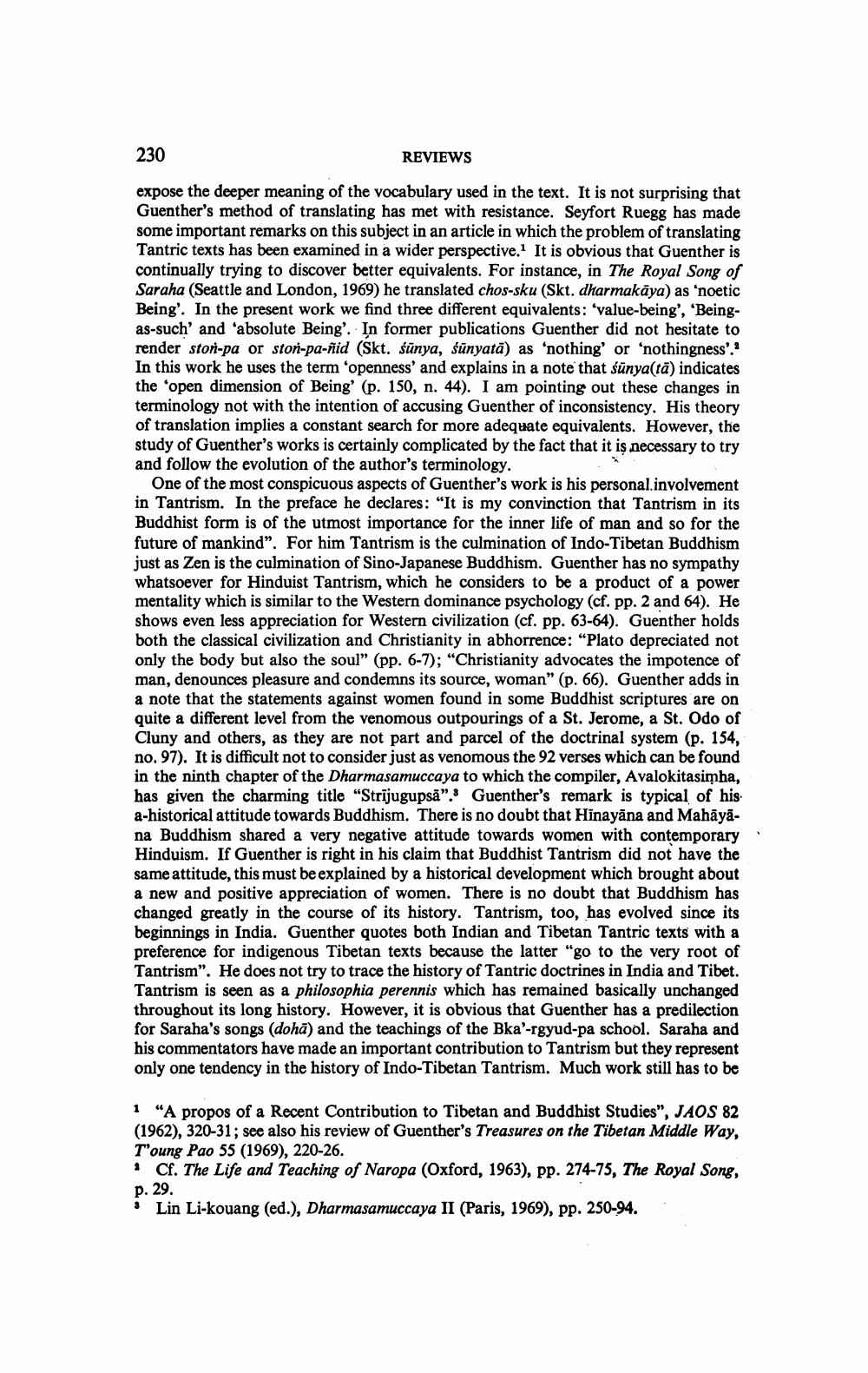Book Title: Reviews Of Different Books Author(s): Publisher: View full book textPage 6
________________ 230 REVIEWS expose the deeper meaning of the vocabulary used in the text. It is not surprising that Guenther's method of translating has met with resistance. Seyfort Ruegg has made some important remarks on this subject in an article in which the problem of translating Tantric texts has been examined in a wider perspective. It is obvious that Guenther is continually trying to discover better equivalents. For instance, in The Royal Song of Saraha (Seattle and London, 1969) he translated chos-sku (Skt. dharmakaya) as 'noetic Being'. In the present work we find three different equivalents: 'value-being', 'Beingas-such' and 'absolute Being'. In former publications Guenther did not hesitate to render ston-pa or ston-pa-nid (Skt. sunya, sunyata) as 'nothing' or 'nothingness'.: In this work he uses the term 'openness' and explains in a note that sunya(ta) indicates the 'open dimension of Being' (p. 150, n. 44). I am pointing out these changes in terminology not with the intention of accusing Guenther of inconsistency. His theory of translation implies a constant search for more adequate equivalents. However, the study of Guenther's works is certainly complicated by the fact that it is necessary to try and follow the evolution of the author's terminology. One of the most conspicuous aspects of Guenther's work is his personal.involvement in Tantrism. In the preface he declares: "It is my convinction that Tantrism in its Buddhist form is of the utmost importance for the inner life of man and so for the future of mankind". For him Tantrism is the culmination of Indo-Tibetan Buddhism just as Zen is the culmination of Sino-Japanese Buddhism. Guenther has no sympathy whatsoever for Hinduist Tantrism, which he considers to be a product of a power mentality which is similar to the Western dominance psychology (cf. pp. 2 and 64). He shows even less appreciation for Western civilization (cf. pp. 63-64). Guenther holds both the classical civilization and Christianity in abhorrence: "Plato depreciated not only the body but also the soul" (pp. 6-7); "Christianity advocates the impotence of man, denounces pleasure and condemns its source, woman" (p. 66). Guenther adds in a note that the statements against women found in some Buddhist scriptures are on quite a different level from the venomous outpourings of a St. Jerome, a St. Odo of Cluny and others, as they are not part and parcel of the doctrinal system (p. 154, no. 97). It is difficult not to consider just as venomous the 92 verses which can be found in the ninth chapter of the Dharmasamuccaya to which the compiler, Avalokitasimha, has given the charming title "Strijugupsa". Guenther's remark is typical of his a-historical attitude towards Buddhism. There is no doubt that Hinayana and Mahaya. na Buddhism shared a very negative attitude towards women with contemporary Hinduism. If Guenther is right in his claim that Buddhist Tantrism did not have the same attitude, this must be explained by a historical development which brought about a new and positive appreciation of women. There is no doubt that Buddhism has changed greatly in the course of its history. Tantrism, too, has evolved since its beginnings in India. Guenther quotes both Indian and Tibetan Tantric texts with a preference for indigenous Tibetan texts because the latter "go to the very root of Tantrism". He does not try to trace the history of Tantric doctrines in India and Tibet. Tantrism is seen as a philosophia perennis which has remained basically unchanged throughout its long history. However, it is obvious that Guenther has a predilection for Saraha's songs (doha) and the teachings of the Bka'-rgyud-pa school. Saraha and his commentators have made an important contribution to Tantrism but they represent only one tendency in the history of Indo-Tibetan Tantrism. Much work still has to be 1 "A propos of a Recent Contribution to Tibetan and Buddhist Studies", JAOS 82 (1962), 320-31; see also his review of Guenther's Treasures on the Tibetan Middle Way, T'oung Pao 55 (1969), 220-26. * Cf. The Life and Teaching of Naropa (Oxford, 1963), pp. 274-75, The Royal Song, p. 29. Lin Li-kouang (ed.), Dharmasamuccaya II (Paris, 1969), pp. 250-94.Page Navigation
1 ... 4 5 6 7 8 9 10 11 12 13 14 15 16
